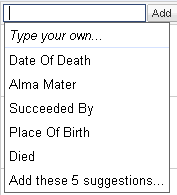It's Google, but Squared! -By Steven W. Anderson

Finding information online is easy. You go to a search engine, type in what you are looking for and with a few mouse clicks you have an answer...most of the time. Teaching kids how to search is easy. Teaching them how to do quailty search is a bit of a challenge but not impossible. When I was in the classroom, one of the hardest things to teach was organizing information found on the web in such a way that it was easy to see and garnish what was needed.
One June 3, Google unveiled, quietly, what they say is the next "big-thing" in search. Google Squared changes the way you look at information on the web. But what is it? Why is it so good and why do I think it will change the way students conduct research online.
First, Google Squared is a search engine. It works just like the regular ol' Google Search you turn to. Type in a search term and you are presented with results. What is different is how the results are presented and what you can do with the data.
For this review I am going to use the search term "British Prime Ministers." When you do a regular Google Search you get what you expect, several sites that contains lists of British PM's. Students would then have to work through each of the links, trying to find the information, not knowing how that information is going to be organized on each resulting page.
With Google Squared the search results are presented in a table. Results are organized horizontally with several pieces of information (or what Google calls Attributes.) In the case of the British PM's you get the name, picture, description, date of birth, religion and who they were proceeded by. All of the results in each of those columns comes from different places on the web, organized in the Squares. You can check the information for each Result and Attribute but clicking the link in the Square. (Remember, its always a good idea to double check where the information is coming from.)

So how could this be of benefit for students. Lets say I want my students to research British PM's and I don't want them to know the religion, rather, I want them to know the date of death and political party. Again, these could all be separate searches on multiple pages, taking lots of time. In the Square you can designate what Attributes you want displayed. There are suggestions for Attributes or you can type your own. In the case of date of death, that is a suggestion. However, political party is not. So I type it in and am presented with the political parties for all the British PM's.

Do you not like one of the search results, or do not need one of the search results? Press the X and it goes away. So basically your search results are customized for your needs or what you want your students need.
Tools and ideas to transform education. Sign up below.
Try some of these cool searches:
Baseball Teams
Types of Dogs
Elements
Roller Coasters
These are just some examples of how you could use Google Squared. Remember, this product is still a baby, so there are going to be mistakes or search results that just don't fit. But I am sure, just as other Google products, it will get better. So, head on over to Google Squared and give it a try!
